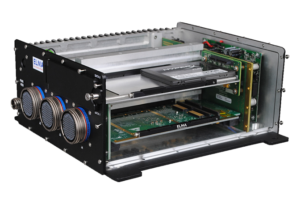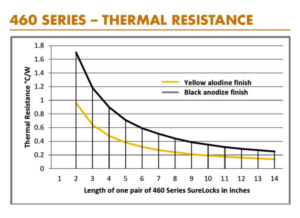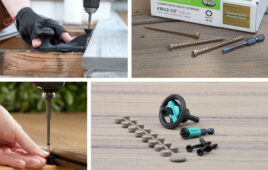Written by Tim Bretz, EC&IC division manager
Elma Electronic
Mounted directly to a printed circuit board (PCB), a card retainer — also called a wedge lock — securely holds the board in place. It’s used to reduce the risk of damage to the electronics within an embedded system and is often overlooked.

The use of extruded aluminum offers card retainers lightweight, yet exceptionally strong features.
Most applications requiring card retainers are found in avionics. One of the critical aspects of a quality card retainer is the ability to maintain uniform clamping force across the length of the card. This is particularly important if subjected to the extreme shock and vibration levels typically found with these types of application.
This force is needed to maintain solid mechanical rigidity and maintain the surface-to-surface contact that provides heat management.
In particular, the number of wedges used (a customizable feature on a card retainer), has direct bearing on the performance of the retainer. A higher number of wedges, the more clamping force and thermal transfer.
There are also several other features hiding behind the scenes of the simple card retainer, such as coined edges, which facilitate a smooth insertion and extraction from a system. The use of extruded aluminum gives the card retainers a lightweight, yet exceptionally strong, construction — a critical component in mobile and airborne applications.
And these versatile components offer a surprising number of options to enable customized solutions that match the operating environment. So, what exactly makes a card retainer right for a given application?
The features
Popular design elements include multi-segment retainers that can be manufactured to a specific length to meet the needs of an application, as well as the choice of the size and style for mounting holes. Both of these are important attributes in the growing small form factor (SFF) space.
There are other features that allow an engineering to “custom design” a card retainer to his or her application. Different locking mechanisms, typically either screwed-in or lever-based, are used to ensure that the card retainer is secured. This should include visual indicators that confirm whether the retainer is closed or open.
Most card retainers for high G force applications require the use of a screwdriver to ensure the board is securely in place. However, there are a few “tool-less” retainers that can adequately secure a board, using a lever built into the card retainer itself. While this design may work for certain, less rugged applications, care must be taken to avoid over-tightening the lever. This can result in a costly repair if the walls are damaged, since most avionics enclosures are milled and will therefore require the entire unit be removed for repair.
Similarly, any blemishes in the spray-coated finish will impact thermal management, typically requiring an entirely new finish be applied to the enclosure. The best bet is to consider how harsh and mobile the environment, as it may necessitate a screwed-in card retainer.
Built-in heat transfer
Although generally used in mobile, mission-critical, and rugged applications, card retainers have found a home in stationary industrial environments as well. This is thanks to their inherent thermal management properties that exist because of the strong contact the card rails have to the enclosure.
 For example, with a simple turn of a screw, Elma’s SureLock retainers expand to securely hold the PCB in place and facilitate conduction cooling by pulling heat from the card and transferring it to a cold plate or extruded wall of the enclosure. These retainers also offer a visual indication that the card has been properly secured in the form of a red screwhead that’s no longer visible when the proper tightening has been achieved.
For example, with a simple turn of a screw, Elma’s SureLock retainers expand to securely hold the PCB in place and facilitate conduction cooling by pulling heat from the card and transferring it to a cold plate or extruded wall of the enclosure. These retainers also offer a visual indication that the card has been properly secured in the form of a red screwhead that’s no longer visible when the proper tightening has been achieved.
Test performed on these types of card retainers have shown impressive thermal transfer capabilities in two different types of finishes, Yellow Alodine and Black Anodized. Another popular finish is electroless Nickel, which typically rates even higher than an anodized finish.
It’s important to note the difference between the types of finishes and the associated clamping force. Yellow Alodine and Black Anodize are popular options, both offering good clamping force and thermal properties. The most commonly specified finish is anodized since it typically provides the optimum cost-to-performance ratio. If viewed under a microscope, one would see an almost peak-and-valley type architecture that provides increased stability to hold two surfaces in place.
If frequent removal of the cards is needed, however, this may not be the best option, since retainers can get stuck from this friction when removing. Electroless Nickel may be a better option for these types of applications, although it comes with a heftier price tag, in the neighborhood of a 25% increase. Nonetheless, it is also the most efficient because it provides superior clamping force and exceptional thermal properties.
Specify early
Some of the simplest engineering oversights have caused catastrophic system failures and card retainers are not immune. If your application will require a card retainer, it’s best to evaluate your needs early in the design process or you run the risk of being stuck with some unforeseen design challenges.
Some common pitfalls when specifying card retainers in at the end of the process include:
- No room on the board: if you don’t make provisions for the placement of the card retainers, certain components may be in the way of where the rails need to go on the board itself.
- Ground planes on the outside: to ensure proper thermal transfer, the ground planes should be positioned to conduct as much heat as possible to the outside of the enclosure. Waiting until the end may limit your options.
- Rails are too short: Nothing is worse than discovering your rails don’t extend across the entire length of your board. Make sure the retainers are properly matched to your system’s dimensions.





Tell Us What You Think!